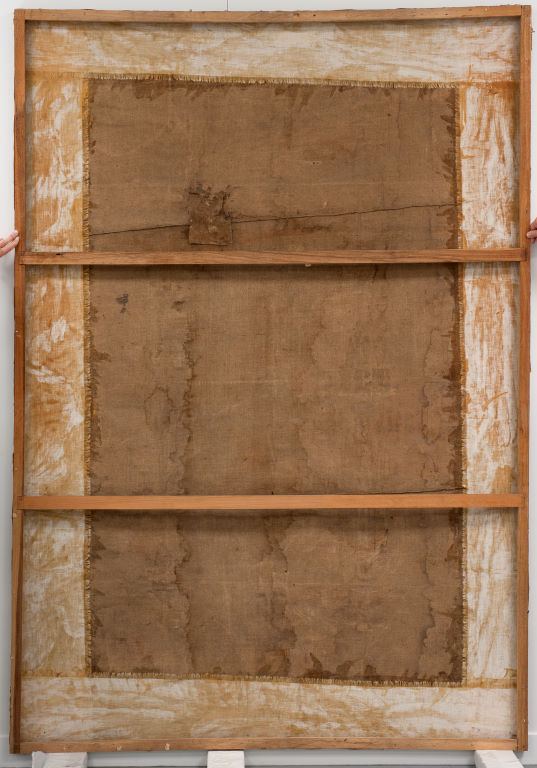 |
| Before treatment picture of the print in its frame |
The Mocking of Christ is an impressive printed work on paper measuring over 2 metres tall and 1.5 metres wide. It was copied by François Langot, a 17th century French engraver from a now lost painting by Sir Anthony van Dyck. Langot specialized in making large scale prints that were used as altarpieces by churches too poor to acquire important paintings of their own. The engraving is made up of nine separate plates printed on individual sheets of paper joined together to make up one image.
The original oil painting by van Dyck of the Mocking of Christ which Langot copied belonged to Sanssouci, Potsdam (Germany). A record published in 1833 states that the painting had originally belonged to the King of Prussia and measured more or less the same size as our print. A drawing after another version by van Dyck is held in The Louvre (France). It is very similar to our print, but Christ’s hair is being pulled to the right of the image by one of the torturers whereas in our print Christ looks serenely away from the mocking figure offering him a bulrush as a sceptre.
This engraving is special for several reasons: its rarity, its size, the fact that van Dyck’s oil painting is believed to have been destroyed in World War II and that there are very few prints made by Langot as he died relatively young.
The only other known examples of this engraving are held in the collections of the Bibliothequè Royale in Brussels (Belgium), the Museums of the Vatican, and in the Irbit State Fine Arts Museum (Russia). Research has revealed that the impression at the Bibliothequè Royale is in perfect condition because the nine sheets are loose and have never been joined. Our print however, was assembled and pasted down onto a canvas backing, probably in the 18th century.
 |
| The folio of unassembled engravings held at the Bibliothequè Royale, Brussels |
CONDITION OF THE PRINT
The print has suffered significant damages through the centuries, notably an earthquake and associated flood, and so came to us in a particularly poor condition. Several areas were cause for concern on close examination:
- Disfiguring dark brown water stains resulting from the flooding
- Black and pink mould stains due to dampness
- Numerous areas of paper loss and cracks
- A very thick layer of embedded dust, accretions (wax, insect droppings, paint splashes etc) and insect damages, such as borer holes
- An area of black over-paint on the knees of Christ
- Extensive fold lines and creases.
 |
| These details of the print show water stains, cracks, losses and black over-paint on Christ’s knees in the left image. The right image shows the original misalignment of the joined sheets. |
 |
| This raking light picture allows us to see the extent of the creases and fold lines. |
TREATMENT PROPOSAL
First, the print needed to be removed from the stretcher and then from the canvas lining, so that we were able to treat the paper. Vacuuming and dry-cleaning was necessary to remove dust and accretions from both the back and front. As it was extremely difficult to work on the print in its large format, we decided to separate it into the nine printed sheets and treat them individually: they all need aqueous treatment, consolidation of weak areas and repair with antique papers where the original paper and image is lost. We intend to rejoin the nine sheets, after lining them with a new conservation support and retouch the repaired areas. However, our initial treatment proposal was not followed completely as we first thought, as some aspects of the treatment were not entirely predictable, and we discovered new problems that pushed us to find an alternative solution.
In the next episode, you will find out about the tests that have been undertaken on the print and the beginning of the treatment. Stay tuned!
- Ute Larsen and Camilla Baskcomb, Works on Paper Conservators

2 comments:
Looking forward to the next instalment, that's a huge and delicate project you have undertaken. Good luck!
This was a pleasure to read! Congratulations Ute, Camilla and the team at Auckland Art Gallery. Many people are excited to see the restored final!
Post a Comment